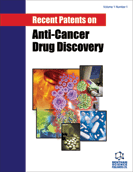
Abstract
Background: Receptor Tyrosine Kinases (RTKs) play critical roles in a variety of cellular processes including growth, differentiation and angiogenesis, and in the development and progression of many types of cancer. Mesenchymal-Epithelial Transition Factor (c-Met) kinase is one of the types of RTKs and has become an attractive target for anti-tumor drug designing. c-Met inhibitors have a broad prospect in tumor prevention, chemotherapy, biotherapy, and especially in tumor resistance.
Objective: The purpose of this article is to review recent research progress of c-Met inhibitors reported in patents since 2015.
Methods: A comprehensive Scifinder and Web of Science literature review was conducted to identify all c-Met inhibitors published in patents since 2015.
Results: There are two kinds of c-Met inhibitors, one is from natural products, and the other one is of synthetic origin. Most of these c-Met inhibitors show potent in vivo and in vitro antitumor activities and have potential in the treatment of cancers.
Conclusion: c-Met kinase inhibitors have emerged as an exciting new drug class for the treatment of all kinds of cancers, especially the Non-Small Cell Lung Cancer (NSCLC) with tumor resistance. More studies should be conducted on natural products to find novel c-Met kinase inhibitors.
Keywords: Cancer, c-Met, inhibitors, patent, progress, receptor tyrosine kinases.
[http://dx.doi.org/10.1186/s12943-018-0797-x] [PMID: 29455658]
[http://dx.doi.org/10.1111/cas.12897] [PMID: 26801869]
[http://dx.doi.org/10.1016/j.cell.2010.06.011] [PMID: 20602996]
[http://dx.doi.org/10.1016/j.lungcan.2018.09.008] [PMID: 30429039]
[http://dx.doi.org/10.1016/j.lungcan.2019.04.028] [PMID: 31200831]
[http://dx.doi.org/10.1023/A:1023768811842] [PMID: 12884908]
[http://dx.doi.org/10.1016/j.ejmech.2015.03.041] [PMID: 25827399]
[http://dx.doi.org/10.1016/j.ejmech.2017.08.044] [PMID: 29157685]
[http://dx.doi.org/10.1002/ijc.24554] [PMID: 19569242]
[http://dx.doi.org/10.1200/JCO.2008.19.1635] [PMID: 19255323]
[http://dx.doi.org/10.3390/cancers12010186] [PMID: 31940916]
[http://dx.doi.org/10.1038/srep38502] [PMID: 27917934]
[http://dx.doi.org/10.3390/pharmaceutics12020121] [PMID: 32028611]
[http://dx.doi.org/10.1016/j.biopha.2018.07.055] [PMID: 30119228]
[http://dx.doi.org/10.1007/s40265-016-0661-5] [PMID: 27909994]
[http://dx.doi.org/10.4103/2278-330X.110506] [PMID: 24455567]
[http://dx.doi.org/10.2174/187152007784111313] [PMID: 18045063]
[http://dx.doi.org/10.1073/pnas.1319583110] [PMID: 24218589]
[http://dx.doi.org/10.3748/wjg.v21.i18.5445] [PMID: 25987766]
[http://dx.doi.org/10.1016/j.ejmech.2020.112241] [PMID: 32200199]
[http://dx.doi.org/10.1080/14756366.2018.1533822] [PMID: 30422010]
[http://dx.doi.org/10.1002/9783527654307]
[http://dx.doi.org/10.1111/cbdd.13192] [PMID: 29575727]
[http://dx.doi.org/10.1016/j.bmc.2017.11.010] [PMID: 29146452]
[http://dx.doi.org/10.1158/1535-7163.MCT-12-1079] [PMID: 23468529]
[http://dx.doi.org/10.1021/jm800401t] [PMID: 18553959]
[http://dx.doi.org/10.1002/med.21437] [PMID: 28181261]
[http://dx.doi.org/10.3390/molecules25010010] [PMID: 31861448]
[PMID: 30210922]
[http://dx.doi.org/10.1007/s11030-020-10067-5] [PMID: 32157572]
[http://dx.doi.org/10.1016/j.bmcl.2020.127189] [PMID: 32371098]
[http://dx.doi.org/10.1080/14756366.2019.1702655] [PMID: 31902266]
[http://dx.doi.org/10.1002/cbf.3369] [PMID: 30604499]
[http://dx.doi.org/10.1080/17460441.2019.1551355] [PMID: 30518273]
[http://dx.doi.org/10.1016/j.bmc.2020.115555] [PMID: 32503697]
[http://dx.doi.org/10.1039/D0NJ00575D]
[http://dx.doi.org/10.1016/j.bmcl.2016.02.059] [PMID: 26923692]
[http://dx.doi.org/10.1016/j.ejmech.2020.112244] [PMID: 32224380]
[http://dx.doi.org/10.3390/cancers11050627]
[http://dx.doi.org/10.2174/1568026619666190712205353] [PMID: 31526339]
[http://dx.doi.org/10.6023/cjoc201803041]
 101
101 1
1



























